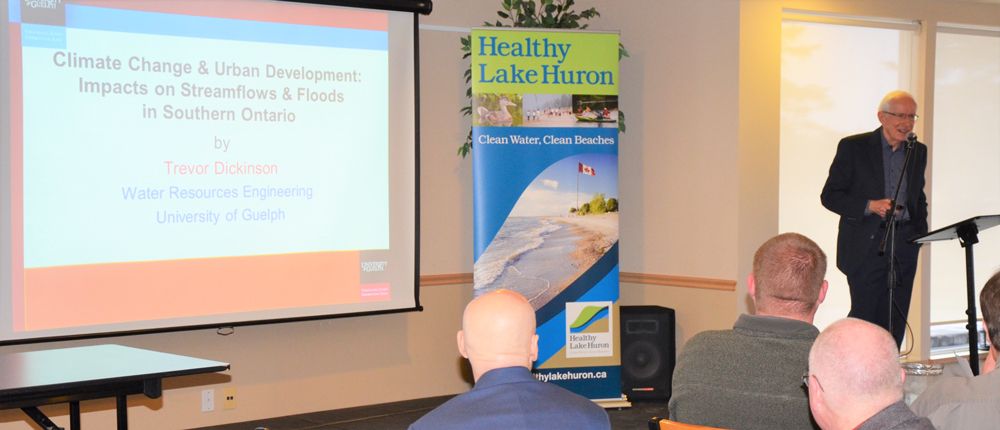Impacts on flooding, streamflow

Patterns for streamflow, flooding in different seasons changing differently for rural, urban areas: speaker tells Partner Appreciation Evening guests
Trevor Dickinson, Professor Emeritus, University of Guelph was guest speaker at Ausable Bayfield Conservation’s annual Conservationist of the Year Award evening on March 21, 2019; Keynote speaker shares data suggesting climate change, urbanization combining to have impact on summer flooding, streamflow in urban areas
Seasonal patterns are changing for streamflow and precipitation in southern Ontario, according to the guest speaker at a March 21, 2019 event. Summer streamflow and flooding are changing differently in urban and rural watersheds, however, according to the presenter.
More than 70 people attended the evening held at Ironwood Golf Club to honour partners in conservation in Ausable Bayfield watersheds. The guests heard keynote speaker Trevor Dickinson, Professor Emeritus, University of Guelph, speak on Climate Change and Development in Rural Areas: Impacts on Streamflow and Floods in Southern Ontario.
The presenter referred to data collected over the years in two watersheds – one urban and one rural. The rural watershed was Moira River at Foxboro, Ontario (north of Belleville). The urban watershed was Don River at Todmorden (in Toronto, Ontario). Data for the rural watershed found an increase in winter streamflow over the years, a decrease in spring streamflow, and summer streamflow that wasn’t changing much over the past 100 years. The story was different for the “highly urbanized watershed” along the Don River where winter flows have increased, spring flows have decreased, and summer flows have greatly increased in volume. “As soon as you start urbanizing, as soon as you start putting in roads and start putting in ditches – you start to make it easier for the water to run off (and) the number of (runoff) events generated goes up,” according to the speaker.
There are about 15 times more runoff events in the urban watershed than the rural watershed during the growing season, according to the speaker. During the growing season, the percentage of rainfall that runs off the ground is about 10 times greater in the urban watershed than a rural watershed, he said.
Southern Ontario is getting warmer, Dickinson said, but one of the biggest changes in temperature is in the winter at night. “Temperatures have gone up, there’s no question, in southern Ontario as in the rest of the world, temperatures have increased and the mean annual temperatures have been going up about the global average of a degree in the last 100 years ... but in southern Ontario we found the winter temperatures have gone up considerably more,” he said. “Nighttime winter temperatures have increased the most.” With winter nighttime temperatures rising, the number of frost-free days is going up as well (the latter increasing even more dramatically). Total winter precipitation hasn’t really changed very much, the speaker said, but the portion of winter precipitation that falls as rain is going up.
Our understanding of climate change can explain some of the changes in weather patterns in southern Ontario but climate change alone does not explain the increased summer runoff in urban areas. Climate change has impacted temperatures and weather patterns but when it comes to storms during the summertime it is the combination of climate change and urban development that has “opened the floodgates” to runoff in urban areas during the summer months, according to the presentation. Localized and downstream flooding have become more likely in summer months in a highly urbanized watershed and streambank and streambed erosion have become much more widespread and severe, according to the speaker.
The researcher’s data so far does not indicate that the number of summer rain events has increased but it does show that the number of summer runoff events in urban areas has “greatly increased.” The Ontario data so far doesn’t indicate an increase in the number or severity of summer rainfall events but it does show the volume and rate of summer runoff and streamflow in the urban area have “greatly increased,” Dickinson said. “While the number of rain events has not increased, the number of summer runoff events in our urban areas has changed phenomenally,” the speaker said. “Whereas the amount and severity of the summer rainfall events has not really changed the volume and rate of that (runoff) coming off has again changed phenomenally.”
In light of the findings in the presentation, the speaker said there is a need for flood forecasting and flood warning systems; to consider how much of southern Ontario should be paved (or not); how to incorporate sufficient green space into future development; to continue to monitor and be aware of changes in weather and climate (both changes that have already been documented in data to date and projected changes predicted by climate models); and to “explore possible impacts on water quality and other environmental conditions.”